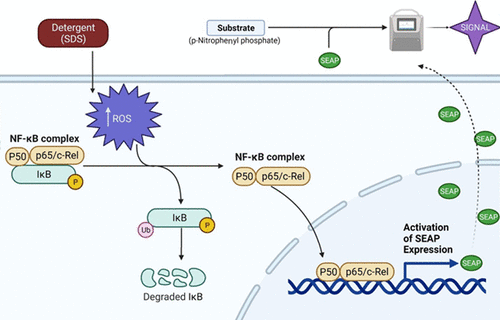当前位置:
X-MOL 学术
›
ACS Synth. Biol.
›
论文详情
Our official English website, www.x-mol.net, welcomes your feedback! (Note: you will need to create a separate account there.)
Development of a Cell-Based Biosensor for Residual Detergent Detection in Decellularized Scaffolds
ACS Synthetic Biology ( IF 4.7 ) Pub Date : 2021-09-22 , DOI: 10.1021/acssynbio.1c00321 Fatemeh Ghorbani 1 , Mohammadreza Abdihaji 2 , Mehryar Habibi Roudkenar 1 , Ammar Ebrahimi 1, 3
ACS Synthetic Biology ( IF 4.7 ) Pub Date : 2021-09-22 , DOI: 10.1021/acssynbio.1c00321 Fatemeh Ghorbani 1 , Mohammadreza Abdihaji 2 , Mehryar Habibi Roudkenar 1 , Ammar Ebrahimi 1, 3
Affiliation

|
Ex vivo engineering of organs that uses decellularized whole organs as a scaffold with autologous stem cells is a potential alternative to traditional transplantation. However, one of the main challenges in this approach is preparing cytocompatible scaffolds. So far, high-precision and specific evaluation methods have not been developed for this purpose. Cell-based biosensors (CBBs) are promising tools to measure analytes with high sensitivity and specificity in a cost-effective and noninvasive manner. In this paper, using the NF-κB inducible promoter we developed a CBB for residual detergent detection. Proximal and core sections of the inducible promoter, containing NF-κB binding sequence, are designed and cloned upstream of the reporter gene (secreted alkaline phosphatase (SEAP)). After transfection into HEK293 cells, stable and reliable clones were selected. After confirmation of induction of this gene construct by sodium dodecyl sulfate (SDS), the stability and function of cells treated by qPCR and SEAP activity were measured. This biosensor was also used to evaluate the cytocompatibility of decellularized tissue. Results showed that the developed biosensor could detect very small amounts of SDS detergent (3.467 pM). It has the best performance 8 h after exposure to detergent, and its stability in high passage numbers was not significantly reduced. Applying this biosensor on decellularized tissues showed that SEAP activity higher than 4.36 (U/L) would lead to a viability reduction of transplanted cells below 70%. This paper presents a novel method to evaluate the cytocompatibility of decellularized tissues. The developed CBB can detect residual detergents (such as SDS) in tissues with high sensitivity and efficiency.
中文翻译:

开发用于脱细胞支架中残留洗涤剂检测的基于细胞的生物传感器
使用脱细胞整个器官作为支架与自体干细胞的离体器官工程是传统移植的潜在替代方案。然而,这种方法的主要挑战之一是制备细胞相容性支架。到目前为止,还没有为此目的开发出高精度和具体的评估方法。基于细胞的生物传感器 (CBB) 是一种很有前途的工具,可以以具有成本效益和非侵入性的方式测量具有高灵敏度和特异性的分析物。在本文中,我们使用 NF-κB 诱导型启动子开发了一种用于残留洗涤剂检测的 CBB。包含 NF-κB 结合序列的诱导型启动子的近端和核心部分被设计并克隆到报告基因(分泌的碱性磷酸酶 (SEAP))的上游。转染 HEK293 细胞后,选择稳定可靠的克隆。在确认十二烷基硫酸钠 (SDS) 对该基因构建体的诱导后,测量了通过 qPCR 和 SEAP 活性处理的细胞的稳定性和功能。该生物传感器还用于评估去细胞组织的细胞相容性。结果表明,开发的生物传感器可以检测到非常少量的 SDS 洗涤剂 (3.467 pM)。它在接触洗涤剂后 8 小时具有最佳性能,并且其在高通道数下的稳定性没有显着降低。将这种生物传感器应用于脱细胞组织表明,高于 4.36 (U/L) 的 SEAP 活性将导致移植细胞的活力降低至 70% 以下。本文提出了一种评估去细胞组织细胞相容性的新方法。
更新日期:2021-10-15
中文翻译:

开发用于脱细胞支架中残留洗涤剂检测的基于细胞的生物传感器
使用脱细胞整个器官作为支架与自体干细胞的离体器官工程是传统移植的潜在替代方案。然而,这种方法的主要挑战之一是制备细胞相容性支架。到目前为止,还没有为此目的开发出高精度和具体的评估方法。基于细胞的生物传感器 (CBB) 是一种很有前途的工具,可以以具有成本效益和非侵入性的方式测量具有高灵敏度和特异性的分析物。在本文中,我们使用 NF-κB 诱导型启动子开发了一种用于残留洗涤剂检测的 CBB。包含 NF-κB 结合序列的诱导型启动子的近端和核心部分被设计并克隆到报告基因(分泌的碱性磷酸酶 (SEAP))的上游。转染 HEK293 细胞后,选择稳定可靠的克隆。在确认十二烷基硫酸钠 (SDS) 对该基因构建体的诱导后,测量了通过 qPCR 和 SEAP 活性处理的细胞的稳定性和功能。该生物传感器还用于评估去细胞组织的细胞相容性。结果表明,开发的生物传感器可以检测到非常少量的 SDS 洗涤剂 (3.467 pM)。它在接触洗涤剂后 8 小时具有最佳性能,并且其在高通道数下的稳定性没有显着降低。将这种生物传感器应用于脱细胞组织表明,高于 4.36 (U/L) 的 SEAP 活性将导致移植细胞的活力降低至 70% 以下。本文提出了一种评估去细胞组织细胞相容性的新方法。


























 京公网安备 11010802027423号
京公网安备 11010802027423号